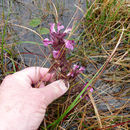Biology
(
İngilizce
)
Arkive tarafından sağlandı
Although it does contain the green pigment chlorophyll and photosynthesizes, marsh lousewort also obtains some nutrients by feeding on the roots of a host plant (3). It is therefore dubbed a 'hemiparasite' (3). It grows as either an annual or a biennial (3). The flowers are pollinated by various bumble-bees, which are attracted to the flowers by the nectar (2).
Conservation
(
İngilizce
)
Arkive tarafından sağlandı
So far, conservation action has not been targeted at marsh lousewort, which is still fairly common in many parts of the country (2).
Description
(
İngilizce
)
Arkive tarafından sağlandı
Marsh lousewort or red-rattle is a widespread hemiparasitic herb (3). The stems and leaves are smooth, or have a few sparse hairs. The stem branches close to the base, and bears roughly triangular-shaped leaves with toothed lobes. The flowers are reddish-pink and the upper lip has a small tooth on each side (2). The name 'red-rattle' refers to both the colour of the flowers and the seed pods, which rattle when the seeds inside become ripe (4).
Habitat
(
İngilizce
)
Arkive tarafından sağlandı
As the name marsh lousewort suggests, this species is found in a broad variety of moist habitats such as wet heaths, wet meadows, fens, ditches, and valley bogs (3).
Range
(
İngilizce
)
Arkive tarafından sağlandı
This plant is fairly common in much of Britain, and it has a wide distribution, reaching altitudes of up to 855 metres (2) . It has undergone a substantial decline in central and southern England (3). Elsewhere it is found in mainland Europe as far south as the Pyrenees. It also occurs in the Caucasus region (Georgia, Armenia and Azerbaijan) (2).
Status
(
İngilizce
)
Arkive tarafından sağlandı
Not threatened at present, but has undergone as substantial decline (3).
Threats
(
İngilizce
)
Arkive tarafından sağlandı
The decline of this species in central and southern England is due largely to the widespread agricultural improvement and drainage of the wet habitats in which it grows (3).

